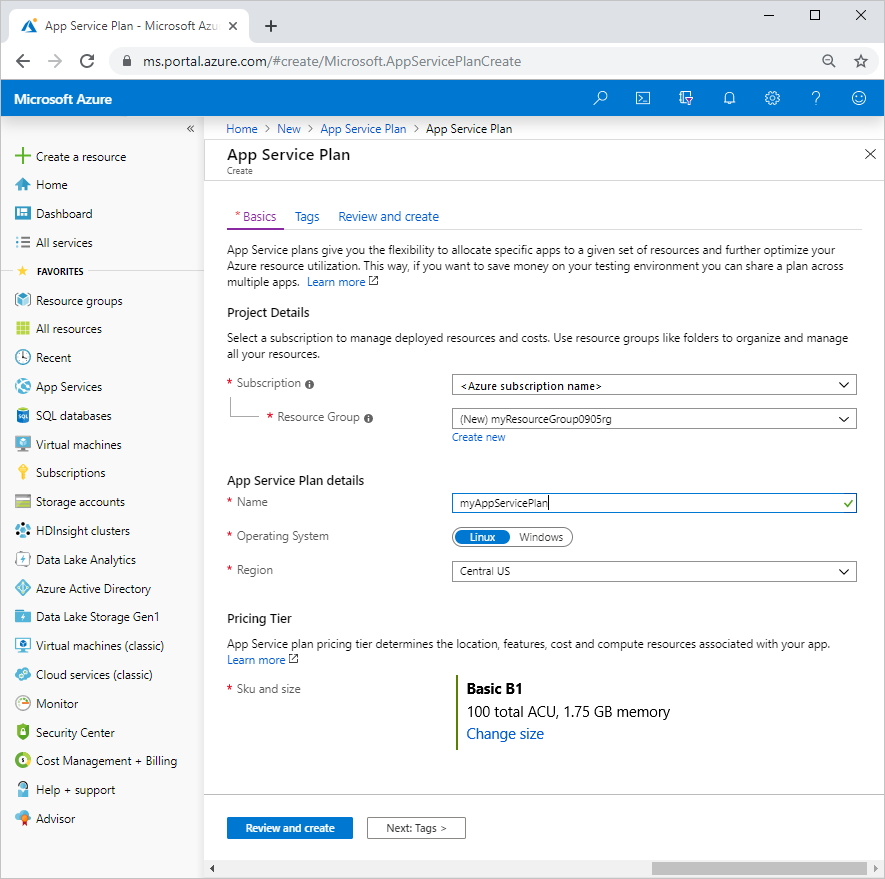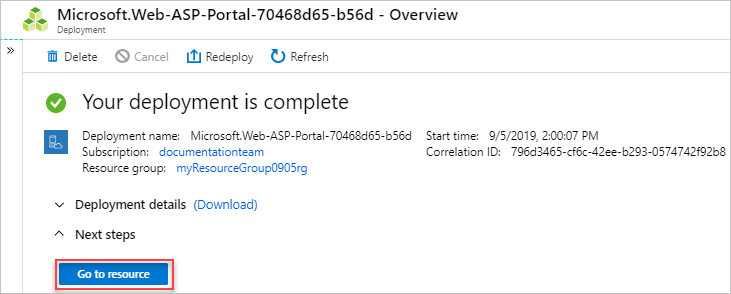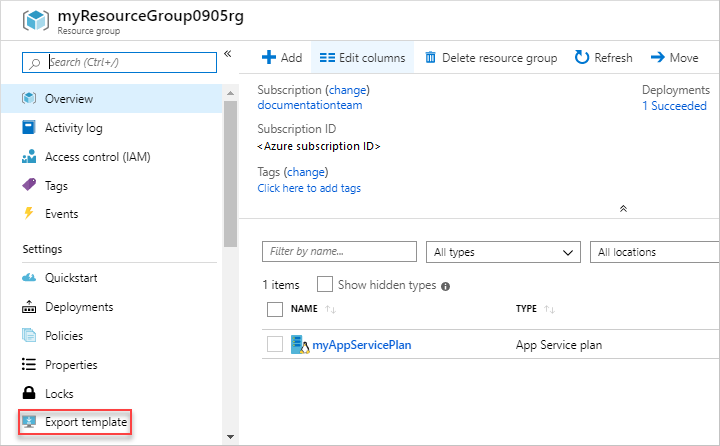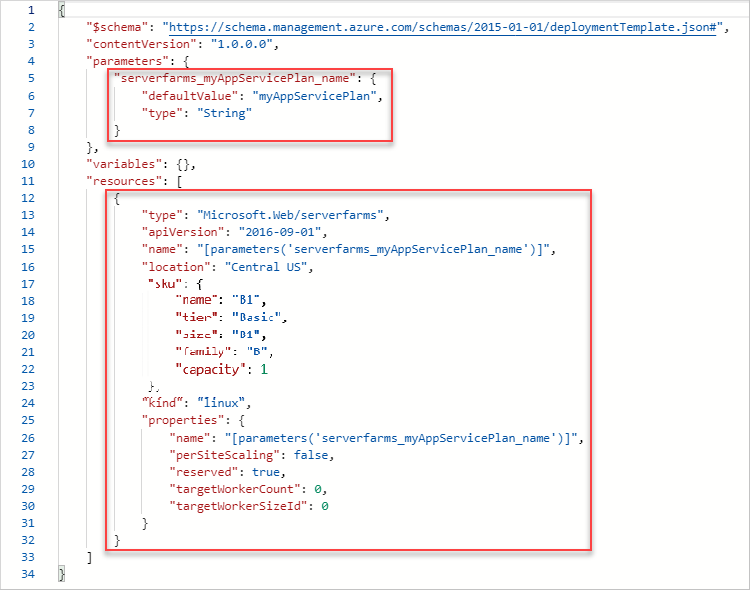Nota:
El acceso a esta página requiere autorización. Puede intentar iniciar sesión o cambiar directorios.
El acceso a esta página requiere autorización. Puede intentar cambiar los directorios.
在本教程系列中,你将创建一个模板来部署 Azure 存储帐户。 在接下来的两个教程中,将添加应用服务计划和网站。 了解如何从 Azure 门户导出模板,以及如何从 Azure 快速入门模板使用示例模板,而不是从头开始创建模板。 自定义这些模板以供使用。 本教程重点介绍如何导出模板并自定义模板的结果。 此说明需要 14 分钟 才能完成。
先决条件
建议完成 有关输出的教程,但不是必需的。
需要具有 Visual Studio Code,以及 Azure PowerShell 或 Azure CLI。 有关详细信息,请参阅 模板工具。
查看模板
在上一教程结束时,模板具有以下 JSON 文件:
{
"$schema": "https://schema.management.azure.com/schemas/2019-04-01/deploymentTemplate.json#",
"contentVersion": "1.0.0.0",
"parameters": {
"storagePrefix": {
"type": "string",
"minLength": 3,
"maxLength": 11
},
"storageSKU": {
"type": "string",
"defaultValue": "Standard_LRS",
"allowedValues": [
"Standard_LRS",
"Standard_GRS",
"Standard_RAGRS",
"Premium_LRS"
]
},
"location": {
"type": "string",
"defaultValue": "[resourceGroup().location]"
}
},
"variables": {
"uniqueStorageName": "[concat(parameters('storagePrefix'), uniqueString(resourceGroup().id))]"
},
"resources": [
{
"type": "Microsoft.Storage/storageAccounts",
"apiVersion": "2025-06-01",
"name": "[variables('uniqueStorageName')]",
"location": "[parameters('location')]",
"sku": {
"name": "[parameters('storageSKU')]"
},
"kind": "StorageV2",
"properties": {
"supportsHttpsTrafficOnly": true
}
}
],
"outputs": {
"storageEndpoint": {
"type": "object",
"value": "[reference(variables('uniqueStorageName')).primaryEndpoints]"
}
}
}
此模板适用于部署存储帐户,但可能需要向其添加更多资源。 可以从现有资源导出模板,以便快速获取该资源的 JSON。
创建应用服务计划
登录到 Azure 门户。
选择“ 创建资源”。
在 搜索服务和市场中,输入 应用服务计划,然后选择 “应用服务计划”。
选择 创建。
在 “创建应用服务计划 ”页上,输入以下内容:
- 订阅:从下拉菜单中选择 Azure 订阅。
- 资源组:选择 “新建 ”,然后指定名称。 提供与本教程系列中所使用的资源组名称不同的资源组名称。
- 名称:输入应用服务计划的名称。
- 作系统:选择 Linux。
- 区域:从下拉菜单中选择 Azure 位置,例如 中国北部。
- 定价层:若要节省成本,请选择 “更改大小 ”以将 SKU 和大小 更改为 第一个基本(B1),在 “开发/测试 ”下,以降低要求较低的工作负荷。

选择“查看并创建”。
选择 创建。 创建资源需要一些时间。
导出模板
选择 转到资源。

在左侧菜单中的 “自动化”下,选择“ 导出模板”。

导出模板功能采用资源的当前状态并生成一个模板来部署它。 导出模板是快速获取部署资源所需的 JSON 的有用方法。
查看导出的模板中的
Microsoft.Web/serverfarms定义及参数定义。 无需复制这些部分。 只需将此导出的模板用作如何将此资源添加到模板的示例。
重要
通常,导出的模板比您创建模板时期望的更冗长。 例如,导出的模板中的 SKU 对象具有五个属性。 此模板有效,但只能使用该 name 属性。 可以从导出的模板开始,然后根据需要对其进行修改。
修改现有模板
导出的模板提供所需的大部分 JSON,但必须针对模板对其进行自定义。 请特别注意模板与导出的模板之间的参数和变量之间的差异。 显然,导出过程不知道已在模板中定义的参数和变量。
以下示例显示了模板的新增内容。 它包含导出的代码加上一些更改。 首先,它会更改参数的名称以匹配命名约定。 其次,它会将您的位置参数用于应用服务计划的位置。 第三,它会删除一些默认值正常的属性。
复制整个文件,然后用它的内容替换你的模板。
{
"$schema": "https://schema.management.azure.com/schemas/2019-04-01/deploymentTemplate.json#",
"contentVersion": "1.0.0.0",
"parameters": {
"storagePrefix": {
"type": "string",
"minLength": 3,
"maxLength": 11
},
"storageSKU": {
"type": "string",
"defaultValue": "Standard_LRS",
"allowedValues": [
"Standard_LRS",
"Standard_GRS",
"Standard_RAGRS",
"Premium_LRS"
]
},
"location": {
"type": "string",
"defaultValue": "[resourceGroup().location]"
},
"appServicePlanName": {
"type": "string",
"defaultValue": "exampleplan"
}
},
"variables": {
"uniqueStorageName": "[concat(parameters('storagePrefix'), uniqueString(resourceGroup().id))]"
},
"resources": [
{
"type": "Microsoft.Storage/storageAccounts",
"apiVersion": "2025-06-01",
"name": "[variables('uniqueStorageName')]",
"location": "[parameters('location')]",
"sku": {
"name": "[parameters('storageSKU')]"
},
"kind": "StorageV2",
"properties": {
"supportsHttpsTrafficOnly": true
}
},
{
"type": "Microsoft.Web/serverfarms",
"apiVersion": "2025-03-01",
"name": "[parameters('appServicePlanName')]",
"location": "[parameters('location')]",
"sku": {
"name": "B1",
"tier": "Basic",
"size": "B1",
"family": "B",
"capacity": 1
},
"kind": "linux",
"properties": {
"perSiteScaling": false,
"reserved": true,
"targetWorkerCount": 0,
"targetWorkerSizeId": 0
}
}
],
"outputs": {
"storageEndpoint": {
"type": "object",
"value": "[reference(variables('uniqueStorageName')).primaryEndpoints]"
}
}
}
部署模板
使用 Azure CLI 或 Azure PowerShell 部署模板。
如果尚未创建资源组,请参阅 “创建资源组”。 本示例假定已将 templateFile 变量设置为模板文件的路径,如 第一个教程所示。
New-AzResourceGroupDeployment `
-Name addappserviceplan `
-ResourceGroupName myResourceGroup `
-TemplateFile $templateFile `
-storagePrefix "store" `
-storageSKU Standard_LRS
注释
如果部署失败,请使用 verbose 开关获取有关要创建的资源的信息。 使用 debug 开关获取调试的详细信息。
验证部署
可以通过从 Azure 门户浏览资源组来验证部署。
- 登录到 Azure 门户。
- 在左侧菜单中,选择 “资源组”。
- 选择部署到的资源组。
- 资源组包含存储帐户和应用服务计划。
清理资源
若要继续学习下一篇教程,则无需删除资源组。
如果您此时停止操作,您可能希望删除资源组。
- 在 Azure 门户中,从左侧菜单中选择 资源组 。
- 在Filter for any field...文本字段中键入资源组名称。
- 选中 myResourceGroup 旁边的框,然后选择 myResourceGroup 或资源组名称。
- 在顶部菜单中选择“删除资源组”。
后续步骤
你已了解如何从 Azure 门户导出模板,以及如何将导出的模板用于模板开发。 还可以使用 Azure 快速入门模板来简化模板开发。